 From Charleville-Meziered France the Voie Verte or Green Way bicycle route is an old rail track that goes unbroken for 80km along the River Meuse to Givet on the Belgium border. Les Ardennes is one of the most beautiful areas with little villages along the way, picnic tables, an abundance of gardens, old stone bridges, a display of mushrooms, bilberries and blossoming roses.
From Charleville-Meziered France the Voie Verte or Green Way bicycle route is an old rail track that goes unbroken for 80km along the River Meuse to Givet on the Belgium border. Les Ardennes is one of the most beautiful areas with little villages along the way, picnic tables, an abundance of gardens, old stone bridges, a display of mushrooms, bilberries and blossoming roses.
Conditions were perfect, the days spectacular and we got to visit with a few barges as they came through the locks in several areas.
You can rent a Peniche for four days to do the Meuse at a cost of 900E and with only half hour instruction.
The lock areas are so well maintained and signs are posted along the way that there is a lock ahead or a place to tie up for the night. The river boats carry a device to open the locks automatically
The river sometimes divides so the canal goes around it and narrows into a forested passage lined with huge conifer trees and nestled between mountainous terrain. The forest was cool with a floor of fern and leafy trees whose leaves fluttered in the wind. It was easy to relax and just flow along with the barges, our biking being at a comparable speed. Occasionally we’d pass a fisherman or two.
Towns along the Meuse have been around since the days when river barges plied the river carrying cargo as the main means of transport.
The trade on the River Meuse, the exploitation of the forest, the beginning of an industry based around the small iron deposit were the only riches of the land until the Industrial Revolution, bringing with it the railway, the canalization of the River Meuse and the improvement of the road work.
 Many of the trails or tow paths we ride were used by animals to haul the barges. The canal boat was ‘harnessed’ to the horses by a rope 50 to 100m long attached to the mast. When overtaking another boat or to avoid obstacles the rope was raised to the top of the mast. If he did not have his own horses, the boatman would call on the help of “long haul” carters, freelance workers, often peasant farmers, who would lead their horses from dawn to dusk. A large number of inns and cafes scattered along the Meuse would house the animals and feed the men. Some canal boats had a stable to accommodate the horses.
Many of the trails or tow paths we ride were used by animals to haul the barges. The canal boat was ‘harnessed’ to the horses by a rope 50 to 100m long attached to the mast. When overtaking another boat or to avoid obstacles the rope was raised to the top of the mast. If he did not have his own horses, the boatman would call on the help of “long haul” carters, freelance workers, often peasant farmers, who would lead their horses from dawn to dusk. A large number of inns and cafes scattered along the Meuse would house the animals and feed the men. Some canal boats had a stable to accommodate the horses.

Do it yourself haulage was a mode of traction occasionally used to return empty for economic reasons and because there were no horses. The boatman and, occasionally his entire family, would attach themselves to the haulage rope, called the ‘bircole’ and would pull the boat. This work was hard and slow and the distance covered at the end of the day rarely exceeded 18 to 20 kilometers.
We rode along beside this barge of two days. On the second day we found the barge tied up along the river. Many of the converted barge owners are very proud of their conversions and love showing you the inside and do not mind us taking pictures. This owner has had the barge for 47 years.
It was built in 1907 the same year his dad was born and is 19m long. Originally it was bigger to carry a cargo of sand but he had the center cut out. The sand was loaded by hand, bit by bit.
He took us inside and the pilot house which was all wood with a big helm and behind it a computer for navigation. Like many of the pilot houses there is a table and setee with double doors opening to the back deck.
The living area was big with wood floors and a new white kitchen.

Also it had a new nice bathroom with a seperated glass door shower. It also had heated tile floors in the bathroom.  Many of the boats are now heating the floors with regular electric heating coils like they use in the houses in winter. Easy to install and ….oh so wonderful we are told.
Many of the boats are now heating the floors with regular electric heating coils like they use in the houses in winter. Easy to install and ….oh so wonderful we are told.
Off a narrow hall there were three separate small bedrooms one with a washing machine.
But the best part of this boat was in the stern under the pilot house and back deck. They had decided to leave this area original. It shows the tiny area where the family lived while hauling the sand. A small door leads through the engine room and into a passage. This passage was also the galley and later the left side pulled down to sleep two children.
 The main living area was only about 6 feet square. There was a table, a dresser and seating for four and an alcove with a double bed.
The main living area was only about 6 feet square. There was a table, a dresser and seating for four and an alcove with a double bed.
You can see the original date of the boat carved in the wood below the port holes, 1907.
 It also had a wood burning fireplace with a carved mantel. Today this area is used for gas bottles for cooking and storage.
It also had a wood burning fireplace with a carved mantel. Today this area is used for gas bottles for cooking and storage.
It was hard to imagine an entire family living in this small space, especially during winter.
A hard life.
Today many of these old boats have been converted and a source of interest to us….but are they too big? After all s/v Ariel was 18m and we want to downsize with less maintenance. Perhaps we should look at a smaller barge.


Okay, what is this? It is a barge but it comes from England and is called a narrow boat. In England, across the channel, the canals are much narrower.
This one is 17m x 2m.
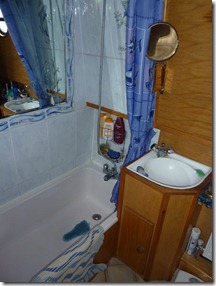
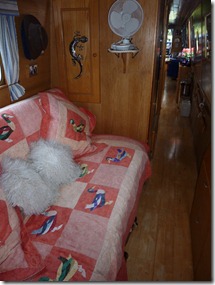
Even room for a bathtub but in the one sleeping cabin the bed is made up into a seating area during the day.

I was almost convinced seeing the garden on the top of the narrow boat but I think we have so much to learn and more boats to see.
Back on the bike trail there is a surprise around every corner. The river on one side, beautiful houses, gardens and more barges to see.

Sometimes it all gets to be a bit overwhelming.
Just when we think we have seen enough along comes one of these beautiful Tjalks an old Dutch barge with the mast down and lee boards up. They remind me of ‘dragonflies’ hovering above the still water.
Coming into the towns on the River Meuse was always fascinating and full of history. Here in Charleville-Meziered an old mill is now a museum for a famous French poet, Arthur Rimbaud called Le Vieux Moulin built in 1626.
While Steve rode off to buy camping gas I sat in the center square admiring an old carrousel.
. 
. As I rode in alone a group of French cyclist taking photo’s came rushing over to me. I could not speak much French but we communicated and had a few laughs. Funny when Steve is not around how these Frenchmen gravitate toward me…. too bad it was the bike that attracted them.
Coming into Revin the bike route took us right to the municipal camping for only 8 Euros a night. We set up our tent just feet from the river behind the hedge. The camp was set among weeping willow trees, flowers and thick green grass, just beautiful.
The town entered History in 762 with the donation of the lands by a German and for one millennium this territory was bordered by two powers, the French Kingdom and the Germanic Empire. For centuries, the inhabitants knew how to take advantage of the natural resources they had in spite of a barren and isolated environment.
The bend in the river had several boats moored up right in town. We talked to a few of the boat owners and all seemed to agree that we might need a broker and were given a few names. The three top names of good builders are Pedro in Groningen NL, Aquanaut in Sneek NL and Linseen built in Maasbracht outside Maastrich NL. We are compiling a list of what we would like as we check Internet and find Holland has hundreds of boats for sale.
As we head north following the direction of the flow of the Meuse we continue on to Givet France where we hear from there the bike route to Rotterdam Holland is another 310km and all down hill.
We never did stay in another Gite but we were fortunate that the little rain we did get was mostly at night. It is sad to leave France as we will miss the good food, nice people and the wonderful Foie Gras.
Once we leave France we must pass through Belgium to reach Holland. Okay, must get going……I am on duck/geese patrol and here comes Steve,
Share on Facebook






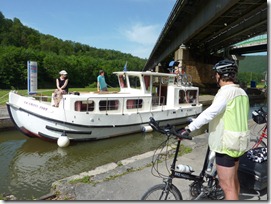










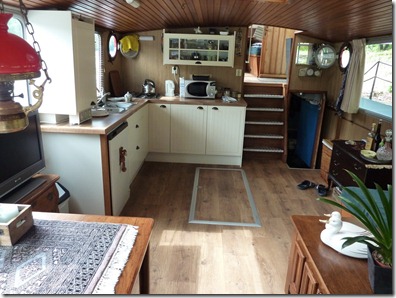













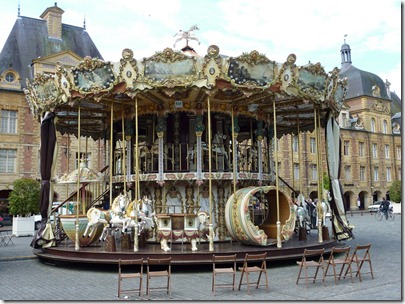



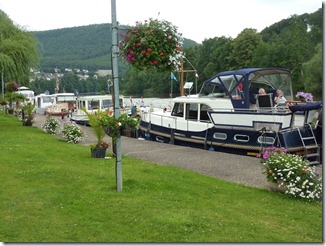






GREAT Pics, Gayla — Thanks soooooo much !!!!!
B&B
Love this! Really enjoying it – thank you.
Thumb up!!!